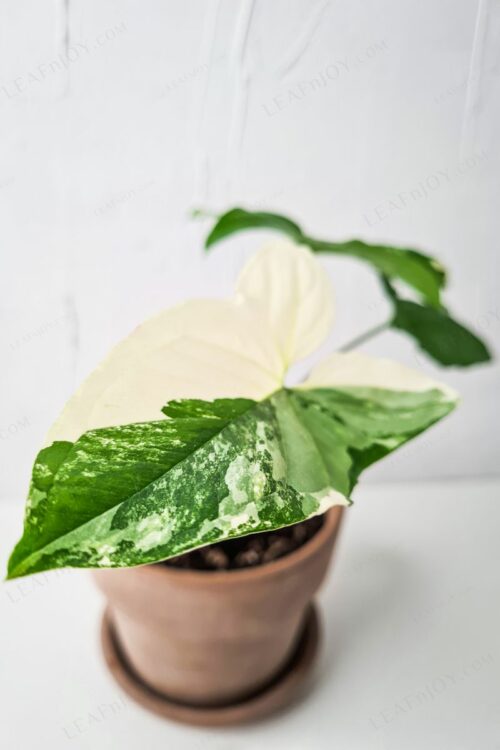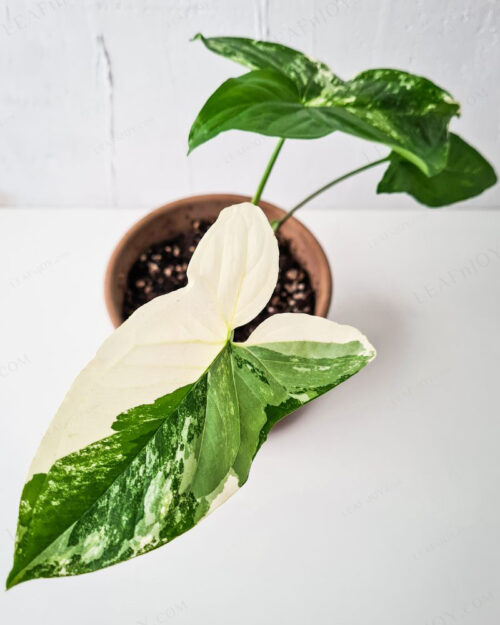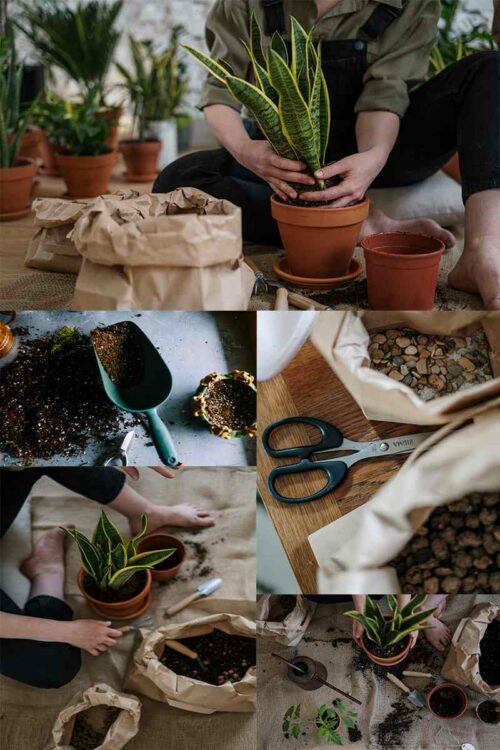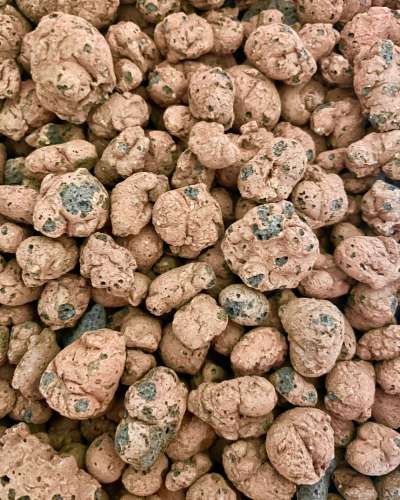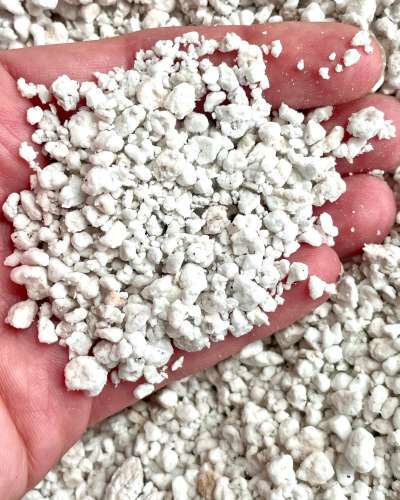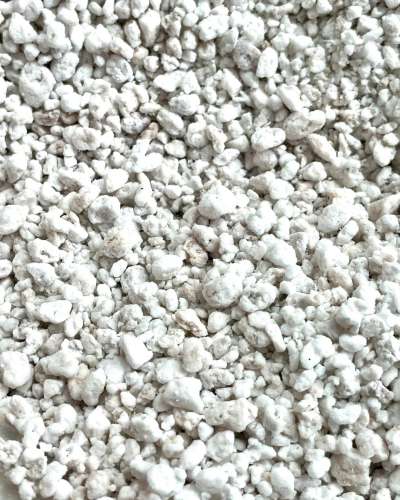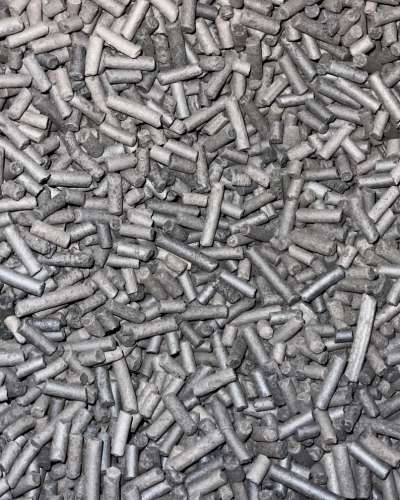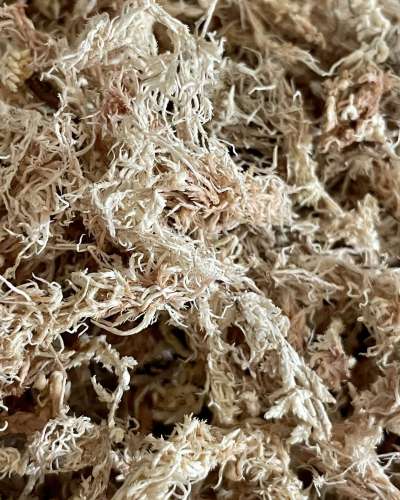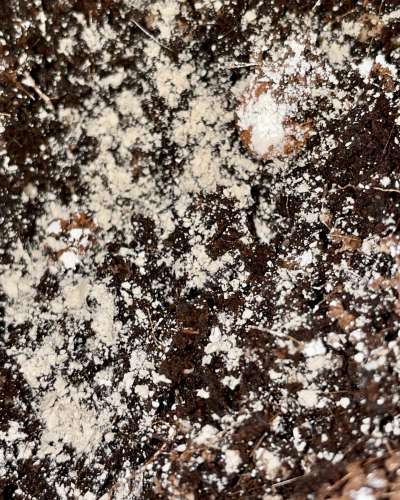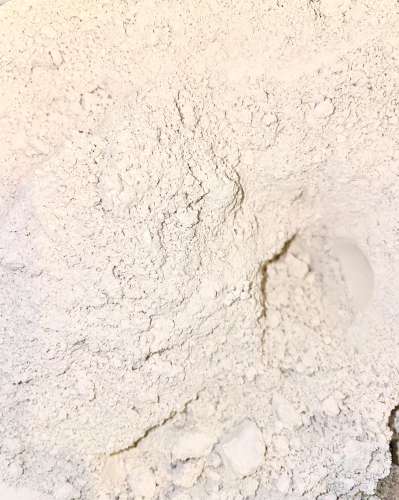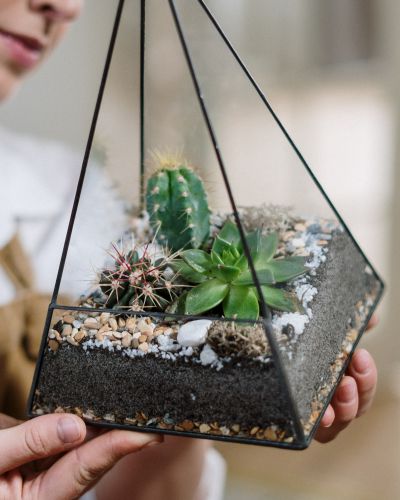How to care for a Syngonium? How often to water an Arrowhead plant? How much light does a Syngonium need? Can my Arrowhead plant stay in the bathroom? How to root Syngonium cuttings?
These Syngonium care-related questions might be on your mind if an Arrowhead plant has recently joined your plant family. I understand that houseplant care might get overwhelming, so this detailed Syngonium care guide is exactly for you.
The good news is that Syngonium are beginner-friendly houseplants that are low-maintenance, can survive in just about any location, grow fast, and are pretty forgiving if neglected from time to time.
Syngonium, also known as Purpurtute or Arrowhead, due to their leaves having a pointy shape, is a genus of plants from the Araceae family (i.e. aroid plants as most call them). Syngonium do flower but their blooms are rarely seen when grown indoors. The Arrowhead plants are native to tropical forests, specifically located in Central and South America, southern Mexico, and Brazil. They are climbing plants that usually grow on top of larger trees and their vines are known to be able to reach the whooping 10-20 m in length.
There are many different Syngonium varieties: over 30 species are found in the plants’ natural habitat. What makes the arrowhead plants one of the most popular houseplants to have are their easy care requirements and their uniquely colored leaves that include strikingly bold shades sometimes. The one type that is most commonly grown in cultivation is the Syngonium Podophyllum which also comes in different vibrant colors. Some of the most popular and sought-after arrowhead plants are Syngonium Confetti, Albo Variegata, Aurea, Strawberry Ice, and Scrambled Eggs Variegata.
Although there are so many different Syngonium varieties, their care requirements are quite similar. If you are here, most likely, a gorgeous Syngonium has captured your heart and now you are perhaps wondering what are the Arrowhead plant care requirements so that it can grow happy and healthy. This guide is for you.
This detailed Syngonium Care Guide covers everything important that you need to know to keep your Arrowhead plant thriving. Some of the topics covered are Syngonium’s potting soil requirements, watering frequency, light needs, fertilizer use, and the easiest ways to propagate these aroid plants.
This post may contain affiliate links. Read our Privacy Policy and Disclosure here.
Syngonium Care – Basic Guidelines
You can find a summary of the care needs of a Syngonium in the table below.
Common Names: Arrowhead, Purpurtute
Origin: tropical rainforests in souther Mexico, Central and South America
Light: can tolerate low light; ideal is medium to bright indirect light
Water: regularly during the growing season; sparingly during the dormant season if the plant is not actively growing
PH: 5.5 – 6.5
Repot: every 2 to 3 years
Temperatures: 18°C to 28°C (64.4 °F to 82.4 °F)
Humidity: 50% to 75%
Nutrition: balanced fertilizer (eg: 10-10-10) or 3-1-2 NPK (or similiar); simple NPK fertilizer isn’t enough so ensure that micro elements are also included
Fertilize: 2 times/year with slow release fertilizer or monthly with liquid one during the growing season; don’t fertilize during winter
Propagation: stem cuttings, division, seeds (rarely)
Pests: scale insects, spider mites, aphids, and thrips
Toxic? Yes, if ingested.
Continue reading for a detailed guide on how to care for a Syngonium grown indoors.
How to Care for a Syngonium
1. How much light does a Syngonium need?
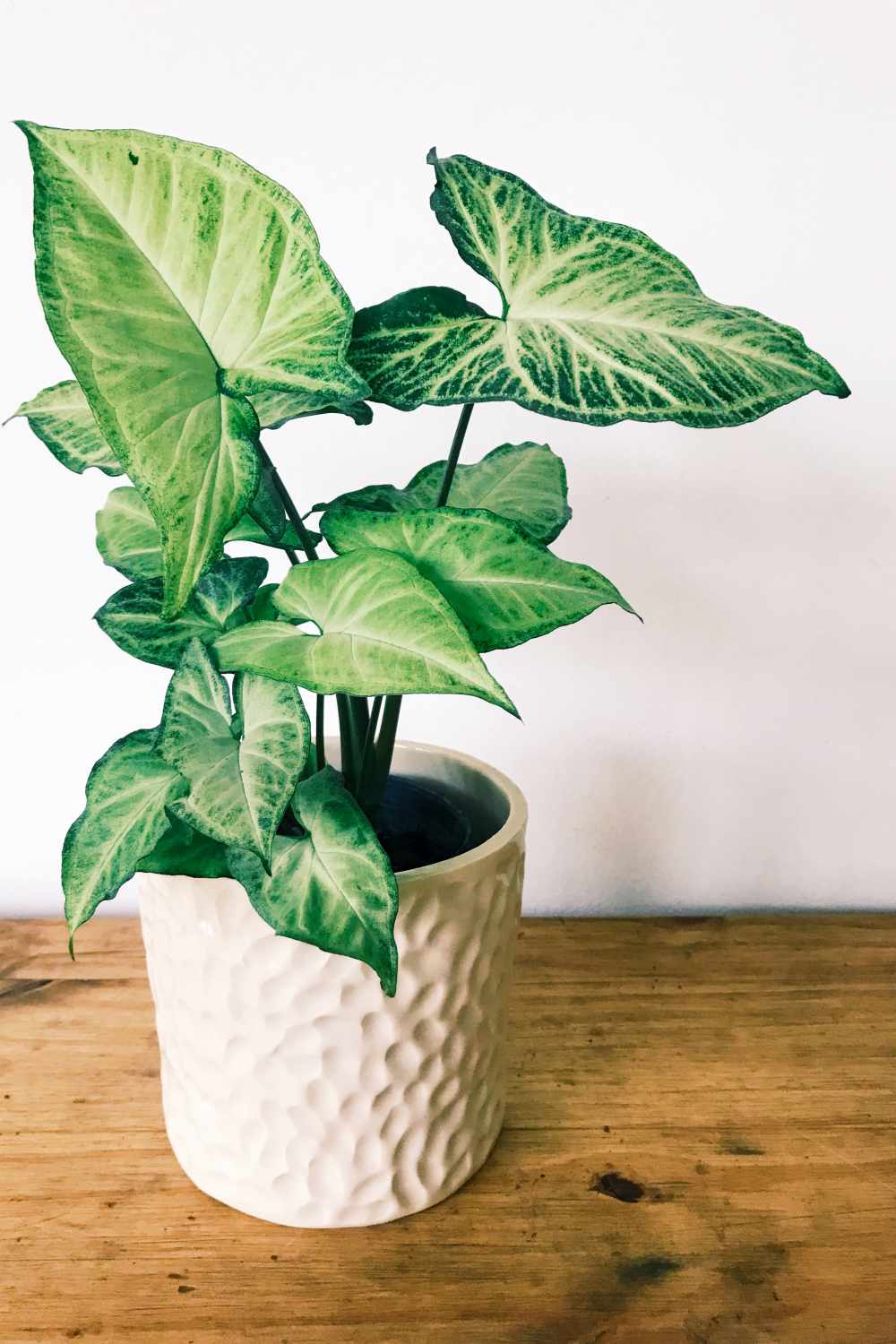
Syngonium will thrive in bright indirect light but since they are not too picky, they will also tolerate medium to low light conditions.
Syngonium can tolerate almost any location that you choose for it (from bright to low-light environments), there are just not so picky and are really easy to please. However, if you want your Arrowhead plant to thrive and grow bushier, find a spot for it that receives bright, indirect light.
Do you want your arrowhead to grow bushier? Light triggers a Syngonium’s growth like no other factor. If your arrowhead plant is receiving sufficient light, not only will it grow faster but there is also a high chance that it will start growing from multiple growth points (nodes). Which in turn will result in a bushier-looking Syngonium, how cool is that!
On the other hand, if your Syngonium is stretching towards the light with greater distances between the nodes, it is most likely an indication that your arrowhead plant is not receiving as much light as it would ideally like. If you can’t offer your Syngonium a location receiving more light, consider investing in a grow light.
But even though light is vital for a Syngonium’s well-being, too much of a good thing can turn bad. Direct sunlight exposure should be avoided, especially when it comes to variegated Syngonium, as the leaves might easily burn.
How much light (PAR) does a Syngonium need? For optimal growth, the PPFD for Syngonium should be between 50-250 umol/m2/s with a lighting period of 12 to 14 hours daily.
How much lux (food candles) do Syngonium plants need? You want to provide your Syngonium with at least 500 lux (50 foot candle) to ensure the plant survives. Aim for at least 3, 000 lux (300 foot candles) for your Syngonium to ensure better growth rate.
You can measure the lux or the PPFD number of a light source by using a light meter (i.e. lux meter).
So a Syngonium would thrive in bright indirect light but how to find that exact sweet spot at your home? I got you. If you are confused about what is bright indirect light for houseplants, make sure to read our easy Lighting Guide for Houseplants.
Note: A low light spot would not work well for a highly variegated Syngonium (eg: Aurea Variegata, Syngonium Albo Variegata) as in general, variegated plants require an extra light boost due to their partially limited ability to photosynthesize due to the variegated parts.
2. How often to water a Syngonium?
Syngonium prefer to be watered regularly and can fast look dramatically sad if you forget to give them a good drink. Dry for too long as well as waterlogging are both no-goes.
It’s important to meet your Arrowhead’s plant water needs, as plants that are experiencing water-related stress are more prone to diseases and pests.
Syngonium love to be kept slightly moist (but not soggy) at all times during the growing season – spring and summer. However, when the weather starts getting colder, your arrowhead plant will most likely slow down its rate of growth and then you have to adjust its watering schedule. As the plant slows down, it will also drink less. Thus, during the colder seasons – autumn and winter, allow the soil of your Syngonium to dry out slightly between irrigations to avoid rot.
Should you water your Syngonium on a schedule? No, the watering frequency of your arrowhead plant will vary based on light, temperature and other environmental factors. Before watering your Syngonium, make sure to always check the moisture level of the soil. You can do this either by using a moisture meter or by simply inserting your index finger into the pot up to your second knuckle. Or deeper if your pot is larger. The general advice is to check the upper one-third of the potting media before watering. If it feels moist: check again in a couple of days, if it’s dry – water your plant thoroughly.
If you don’t want to get dirty and don’t have a moisture meter on hand, lifting the pot of your Syngonium can give you a rough idea of whether the plant needs a drink. If it’s heavy – you can probably wait a couple of days before watering your arrowhead. If it’s light – you can water it.
Are you underwatering your Arrowhead plant? As mentioned, Syngonium can crash relatively fast and look particularly dramatic if they are thirsty. It’s advisable to not reach the point where the plant looks droopy. Rather look for little clues, if the leaves feel a bit softer and the plant just doesn’t look that perky – your arrowhead is probably thirsty. Stunned growth on your Syngonium could be another tell-tale sign that the plant has been experiencing watering stress due to not receiving enough moisture.
Are you overwatering your Syngonium? If your Syngonium starts shedding leaves rapidly and they turn yellow, it could have been overwatered. Usually, you would just need to allow the potting soil to dry out for the plant to bounce back. However, if there is a foul smell coming from the pot of your arrowhead and the plant looks worse, there could be a rot issue going on. Stem rot and root rot are common problems with Syngonium. If there is rotting, it needs to be addressed asap for the best chance of your plant surviving. Check out our detailed guide on how to recognize and treat rot before your plant succumbs to it.
The quality of water and the way you water your Syngonium matters. Our Houseplants Watering Guide can provide you with valuable insights into best watering practices when it comes to houseplants.
3. What is the Best Potting Mix for a Syngonium?
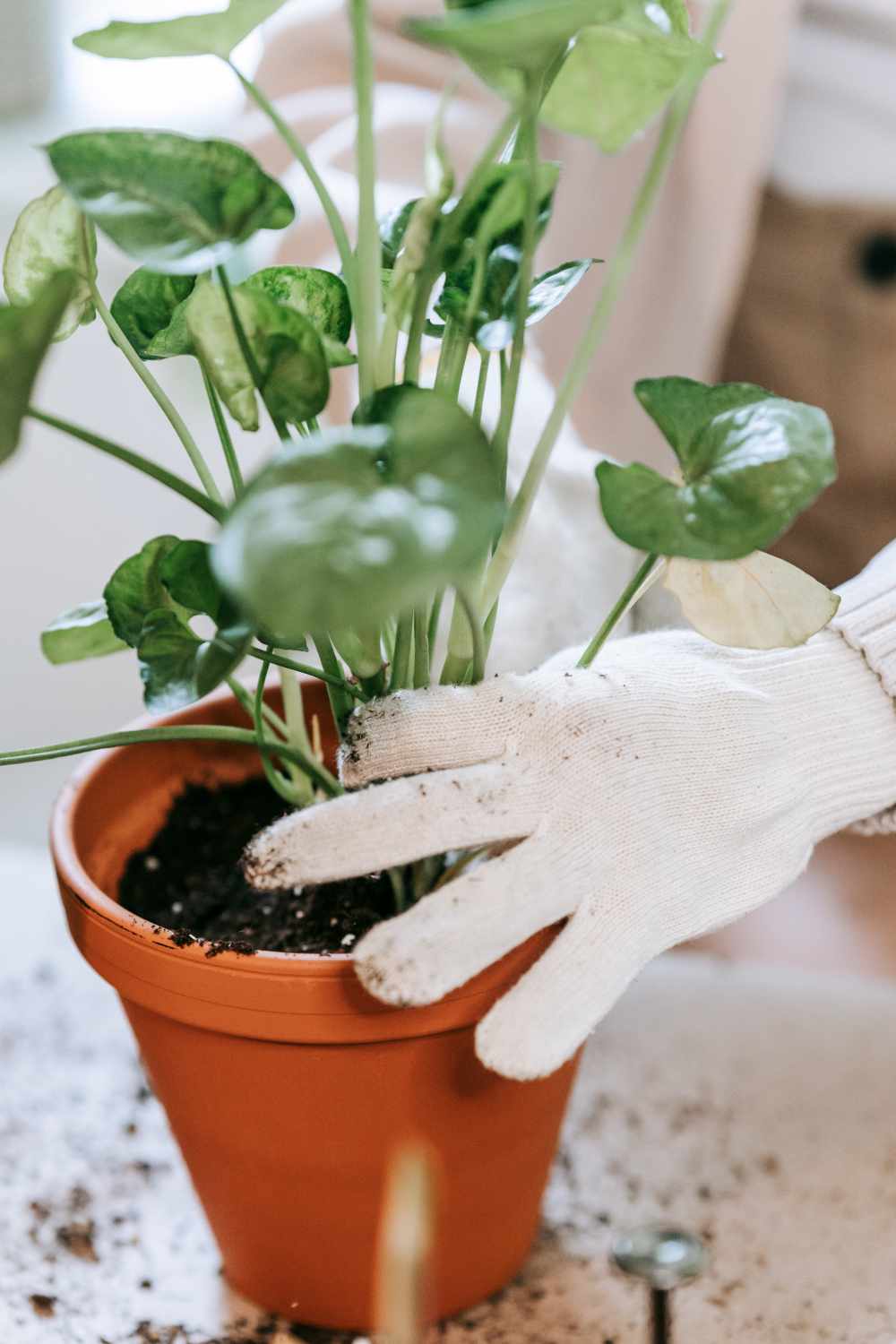
You can grow your Syngonium both in a soil mix or hydroponically.
The best potting mix for an Arrowhead plant grown indoors: Syngonium grow best in a rich but fast-draining potting mix. The majority of arrowhead plants will thrive in an aroid potting mix that provides them with excellent drainage while at the same time retaining enough moisture for the root system. If you don’ feel like getting dirty, your Syngonium will love our aroid potting mix (link). Alternatively, here are two DIY potting mix recipes for a Syngonium:
- Equal parts bark, perlite and high-quality potting mix, or
- Equal parts perlite, high-quality potting mix, coconut coir, cactus & succulents soil mix.
Terracotta pots work also very well for Syngonium as they allow extra air around the root system of the plants. But bare in mind that if you opt to plant your arrowhead in a terracotta versus a plastic pot, the potting media will dry out considerably faster so make sure to check the moisture level regularly.
Can you grow Syngonium in hydro? Yes, absolutely! If you want to give it a go at growing your Syngonium in a soilless way, there are a couple of options. Arrowhead plants can be grown with easy hydroponically, i.e. in water alone. For semi-hydro growing, LECA, pon, and sphagnum moss are also good choices. These growing mediums, however, usually don’t contain any nutrients so ensure to use an appropriate fertilizer if growing your Syngonium in hydro or semi-hydro.
4. How Much Humidity Does a Syngonium Need?
Having a humidifier for a Syngonium is optional, not a must-have.
Arrowhead plants can quickly acclimatize to any environment, but if you want your plant to show you how fast of a grower it can be, consider keeping the humidity around your Syngonium at around 65%. Higher humidity is also beneficial for them in particular as these moist-loving plants don’t dry out as fast then.
As a general advice, the best humidity levels for a Syngonium are between 50% and 75%. Use a hygrometer to measure the humidity in a room.
If you opt to keep your arrowhead plant in a more humid environment, ensure that there is also adequate air circulation around the plant to prevent nasty stuff like fungi and bacteria from finding their home on your Syngonium leaves. You can use any type of fan to increase the airflow around your Arrowhead plant. Ensuring that there is enough air movement close to your Syngonium will also prevent mold from forming on the surface of the soil, limit the chance of edema developing (watery spots on leaves), and will contribute to your plant’s overall well-being.
Another thing to mention is that even though Syngonium can be successfully acclimatized to pretty much any humidity situation, stability is important for them. Sudden drops or humidity highs can stress your Arrowhead plant. This could be especially problematic during winter when heaters are running to warm up a room. Protect your Syngonium from any direct exposure to heaters or wind. And if you notice that your Arrowhead is showing signs of low-humidity-related stress, for example, crispy brown edges on leaves and loss of vigor, consider treating your plant with a humidifier.
5. How Often to Fertilize a Syngonium and Which Fertilizer is Best?
If you have decided to grow your Syngonium in potting soil, then the following guidelines on fertilizing your Arrowhead plant will work well. On the other hand, if your Syngonium is growing in hydro or semi-hydro, it will need different nutrients and feeding frequencies.
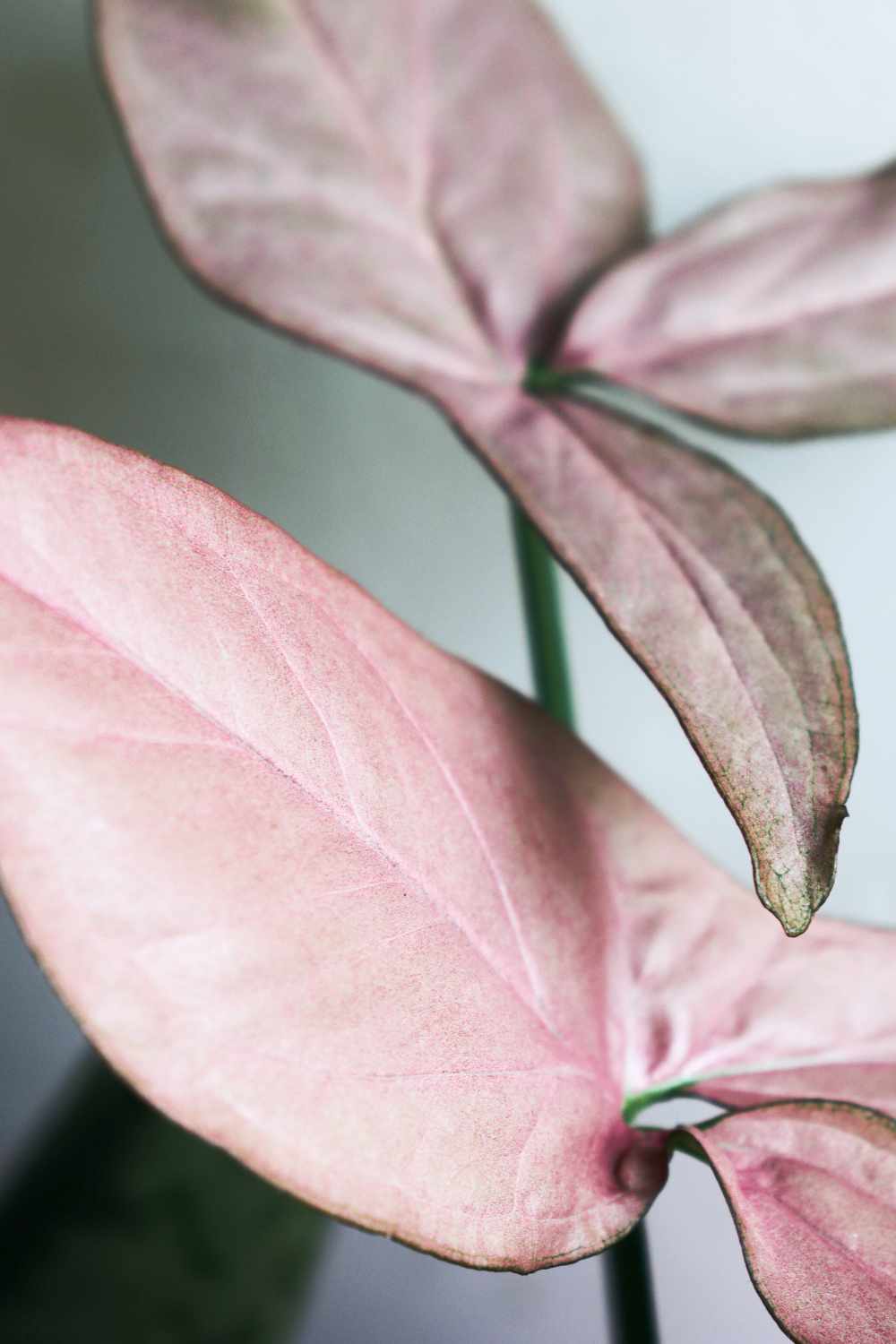
If provided with appropriate light and moisture, Syngonium can grow crazy fast! Thus, they need food.
A Syngonium would need to be fertilized regularly during the growing season (March to October). These tropical plants can grow quite rapidly and thus, regular usage of a fertilizer containing both macro and micro elements is needed to re-fill their depleted nutrients. Bear in mind, however, that a simple NPK fertilizer will not be sufficient, so opt for one that contains trace minerals as well.
What fertilizer is best for Syngonium? A balanced NPK fertilizer (eg: 10-10-10) or one for green leafy plants (eg: 3-1-2 NPK ratio) with micronutrients are both great choices for an arrowhead plant. Both slow-release and liquid fertilizers would work well.
If you opt to use a slow-release fertilizer, apply it based on the manufacturer’s instructions as a top-up soil dressing. Mostly, slow-release fertilizers for Syngonium need to be applied twice per year. One time during early spring (eg: March), and then re-applied during mid-summer (eg: July).
If you’re using a liquid fertilizer for your Syngonium, most apply it monthly and don’t exceed the recommended dose stated on the label. However, our personal preference is to use a fertilization method called “weakly weekly”. This means that the plants are fertilized each week during the growing season with a highly diluted fertilizer dose (eg: 10%-20% of the fertilizer’s recommended dose). Usually, this schedule is followed for 3 weeks, and then comes a week when the plants are flushed with clean water to allow for any salts build-up to clear from the potting media.
Psst, for best nutrients’ absorption, the PH of the water whenever you are fertilizing your Syngonium should be 5.8-6.2.
You can use a PH meter to check it and adjust it before watering your arrowhead plant.
Important: usually, Syngonium slow down their growth significantly once natural light becomes less. If you notice that your arrowhead plant is behaving similarly, don’t fertilize it between the months of October-March, i.e. during the dormant season, as then the plant won’t be eating much and the excess nutrients might cause a fertilization burn.
6. Keep Your Syngonium’s Leaves Clean
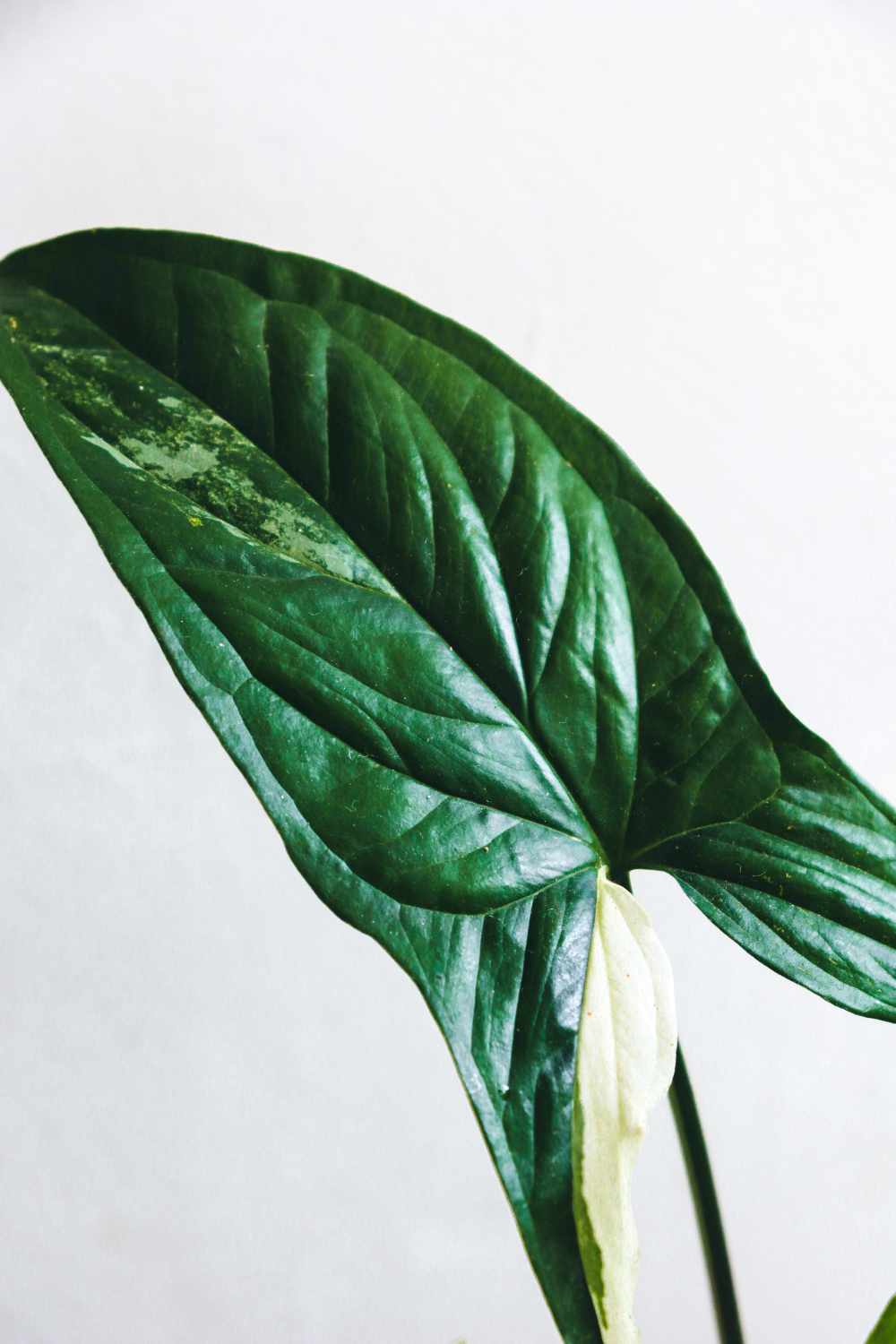
To keep your Syngonium healthy and happy, you want to give your arrowhead a good shower once in a while.
Syngonium’s leaves can become dusty quite fast due to their structure. Dusty leaves are never a good thing as they prohibit the plant from photosynthesizing fully. Also, pests are more prone to be attracted to plants with dust on their leaves as they can freely hide around then. Make sure to regularly give your Syngonium a nice shower to keep those leaves fresh and shiny, and the plant – pest-free. Ensure that you are bathing your plants during the warmer and earlier time of the day, so that the leaves would have sufficient time to dry out and some nasty stuff (like fungus) won’t settle on the foliage. If your Syngonium is too big to be moved, using a soft cloth or a make-up brush, can do the trick.
How often do you need to shower, i.e. clean your Syngonium? That depends. If you notice dust starting to accumulate, it’s time. For most households, that would be once every month to once every 2 months.
7. The Best Growing Temps for a Syngonium
Are Syngonium frost-resistant? No. However, your Arrowhead plant can enjoy growing outside in your garden during spring and summer if the temperatures in your area are warm enough. Remember: You can grow your Syngonium outdoors during the growing seasons but you would need to bring your Arrowhead back in for the winter.
Just like other tropical plants (Monstera, Philodendron, Anthurium, etc), a Syngonium would also not tolerate any temperatures below 10 °C (50 °F) and temperatures below frost will kill the plant, so make sure that your Syngonium is protected from chilly weather conditions at all times.
Your Syngonium can endure temperatures between 12 °C and 36 °C (53.6 °F to 96.8 °F), however, if kept at extremes, your arrowhead plant won’t really thrive.
The optimal temperature range to grow a Syngonium is 18 °C and 28 °C (65 °F to 85 °F).
Remember how I mentioned that Syngonium are prone to experiencing stress when the environment rapidly changes? Avoid exposing your arrowhead to huge temperature differences. They are also not really into winds, so protect them from strong drafts.
8. Should You Stake Your Syngonium?
To stake or not to stake is a common question when it comes to Syngonium care. The answer – it depends.

There are many different Syngonium varieties and some of them don’t need to be staked right from the start.
Depending on the type of Syngonium that you have, you might need climbing support. For instance, a Syngonium Milk Confetti grows in a compact, bushy way, and depending on the direction where the light is coming from, chances are, you won’t need a climbing pole for it. But for a Syngonium Variegata or Syngonium Batik, climbing coir is a fantastic idea as they tend to grow in a stretchy way.
For a young Syngonium, climbing support is not a must. But Syngonium can grow very quickly under the right conditions, so consider in advance providing them with a coir pole. And since arrowhead plants are so responsive to light and will always try to grow towards a light source, staking your Syngonium can help you manage the direction in which the plant shall grow.
9. How to Identify and Treat Pests on Syngonium
Syngonium grow fast, are easy to propagate, caring for them is easy and usually, don’t suffer from pests’ problems. And let’s be honest: Syngonium look absolutely stunning! They are just so perfect, aren’t they?
But to any general rule, there are exceptions. Spider mites, mealybugs, thrips, and aphids are the usual suspects if you think your Syngonium might have a pest problem. We have a detailed guide on identifying and treating pests, so make sure to check it out if you think that your Arrowhead might be under attack.
When it comes to pests and houseplants, prevention is always best but sometimes not possible. The key to dealing with pests is to catch them early on. Make it part of your Syngonium care routine to always inspect thoroughly (bottom to top, underside of the leaves especially) and regularly your Arrowhead plant for a sign of an infestation. A good practice is to do it with every watering but I understand that this can be time-consuming, so strive to do it once monthly on a regular basis at least. Trust me, this will save you loads of trouble in the future. Be especially suspicious once the growing season starts as that’s when most pests start causing problems on plants as well.
Where to look for pests on a Syngonium? Usually (except in the cases of spider mites), pests are located at the top of the plant where new leaves are the most affected since they are more vulnerable and easier to munch on. Boo! However, spider mites, are usually located on the lowest leaves and they expand their dining party from bottom to top. In most cases, pests would be located on the underside of the leaves, hiding away.
If you spot little critters on your precious Syngonium, don’t worry and start getting into action. You can find how to get rid of pests on plants in our detailed guide. But to summarize it: isolate your Syngonium from the rest of your plant collection (you don’t want buggers spreading around!), give it a good shower to dislodge as many bugs as possible, and then treat it with a chosen natural pesticide (eg: neem oil, rubbing alcohol solution). Cover the plant from top to bottom. Repeat the treatment as necessary. Most pest problems on houseplants can be managed naturally. Opt to use chemical pesticides only as a last resort as they are harmful to beneficial insects and the environment.
10. How to Propagate a Syngonium
When provided with enough light, nutrients, and water, Syngonium tend to grow quite rapidly. Thus, if your arrowhead plant is feeling happy and thriving, soon enough you might find that it has outgrown its spot.
Here comes the next good stuff when it comes to Syngonium: they are really easy to propagate too, and if you don’t stop yourself, you might end up with a Syngonium-jungle in your home.
Since Syngonium are fast growers, you might find soon enough that your arrowhead plant has outgrown its spot.
So how are Syngonium propagated? The most widely used method to propagate an arrowhead plant is through stem cuttings. Some plants that have multiple growing points, can also be propagated by separating the stem into multiple plantlets, i.e. also known as propagation through division. Syngonium rarely blooms indoors and the plant might take its time to reach maturity and produce valuable seeds. Thus, seed propagation of the arrowhead plant is rarely done with houseplants.
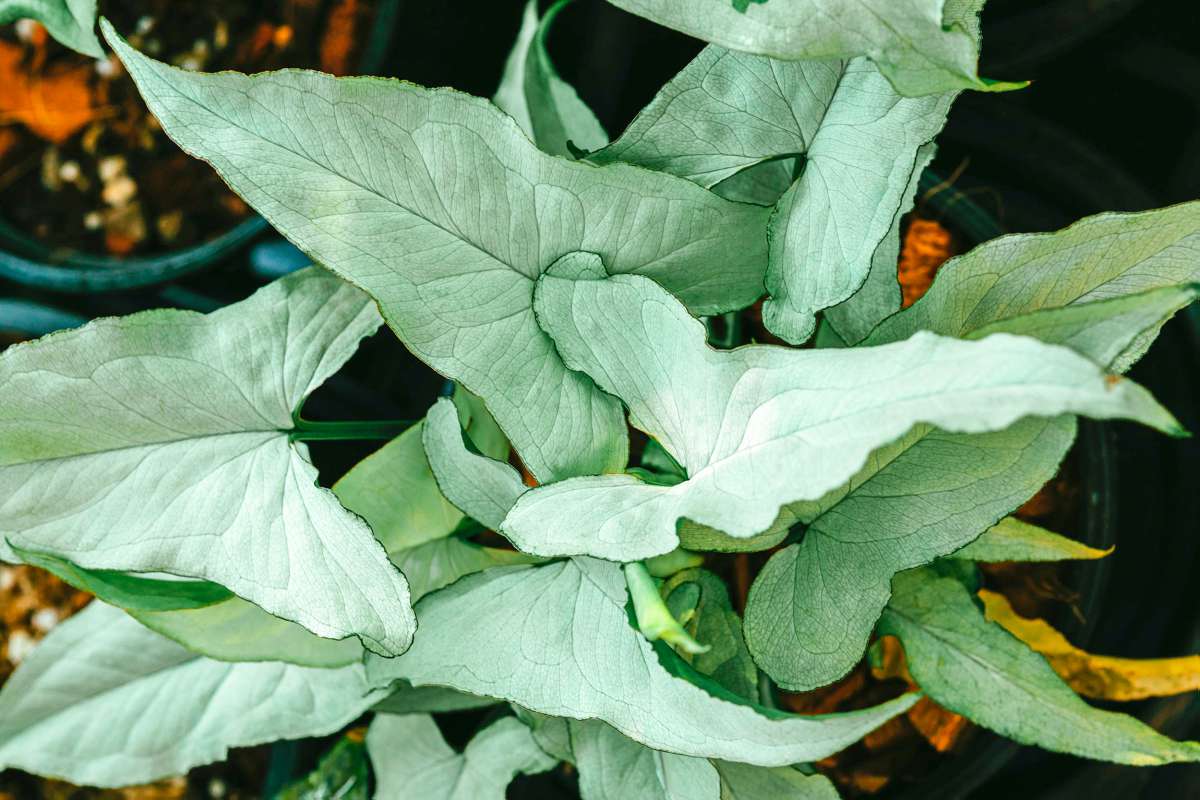
How to air layer a Syngonium? Air layering is another technique that works great for the propagation of Syngonium as roots are allowed to develop before the cutting is taken from the mother plant. It involves you locating a node on your Syngonium and wrapping the aerial roots below that node with moist sphagnum moss. You can secure the sphagnum moss in place by using transparent foil. After some time, little roots should start forming inside the moist moss ball. When the roots have formed, the baby plant is ready to be separated from its parent. Once separated, it can be planted in a growing media of your choice.
Should you propagate a Syngonium through air layering? Our personal opinion is that since Syngonium roots with ease in most cases, air layering is not a must. However, if you are a beginner plant-parent, you might feel a bit anxious taking cuttings from your gorgeous Syngonium mother plant without them having roots just yet. I get it. In this case, air layering is a great method to propagate your arrowhead plant, as it’s almost a bullet-proof rooting method. This is due to there being no chance for the baby plant to die while forming roots as it doesn’t get separated from the mother plant until has its own roots and is ready. So if you would feel comfier using air layering to propagate your Syngonium – go for it. 😊
If you feel like you’re just not into the extra steps involved in air layering a Syngonium, then you can propagate your arrowhead darling either through division or through stem cuttings.
What are the top things to keep in mind to propagate your Syngonium successfully?
Remember how I mentioned that Syngonium slow down their growth rate once natural light becomes less? Thus, you should attempt to propagate your arrowhead plant only during the growing season, i.e. spring and summer. Waiting for the right time to propagate your Syngonium gives you a higher chance of being successful at it.
Once Spring comes around the corner, it’s time to decide on whether your Syngonium is suitable to be propagated through division or stem cuttings.
As mentioned, some Syngonium, when they feel particularly on the bright side, start growing from multiple points (nodes). Hence, they look bushy and have more than one active stem. These can be easily propagated by dividing the stem into multiple sections containing roots and leaves. If your Syngonium is growing like a little bush, then it might be a better idea to separate it than to make cuttings and root them later. If that’s the case, make sure to check out our detailed guide on propagation through division. For example, based on their growth patterns, Syngonium Confetti and Syngonium Milk Confetti are great candidates for this propagation method.
The majority of the Syngonium, however, are best propagated through stem cuttings due to them growing like a vine. Read our step-by-step guide on how to propagate your Syngonium through stem cuttings.
In short: To propagate your Syngonium you need to first locate nodes on the stem where you would like to cut the plant. Ideally, your arrowhead cutting will have at least 2 nodes and 2 leaves on the stem for the best chances of successfully rooting. Cut the mother plant just below a node on the stem and ensure that you are using shears that have been disinfected with rubbing alcohol. Allow the cutting to callus by letting it air dry for a couple of hours before proceeding with rooting it.
If you are unsure what is a node or how to find it, we have these questions answered in our Propagation Through Stem Cuttings Made Easy guide.
After the cutting place has been callused, it’s time to place it in a media where it can form roots. You can place your Syngonium cutting in water to root (rainwater or distilled water are best), plant it in a potting medium and keep it moist (aroid potting mix works well), or choose a semi-hydro culture media. LECA, pon, sphagnum moss and perlite are all good choices to use when rooting a Syngonium cutting. If you opt to root your cutting in water, don’t forget to change the water every couple of days or so with a fresh one.
What is the best way media to use to root a Syngonium? There is no one size fits all. Any of the above media can be used to successfully root a Syngonium cutting. However, we would advise you to root the cutting in the media that you plan to grow the plant later into. This is because water roots are different than soil roots and vice versa, and if you have first rooted your arrowhead cutting in water and then plant it into soil, the baby plant might need some extra pampering while it acclimatizes to its new growing media.
How to increase the chances of your Syngonium cutting rooting successfully?
Once you take a cutting from a Syngonium, the little one will be in shock, separated from the mother plant and on its own, while it still hasn’t developed roots yet. Make sure that you keep the cutting in a bright location but protect it from any harsh light. Grow lights can help if you don’t have an appropriate spot at your home for your arrowhead cutting.
Do you need a heating mat to propagate your Syngonium? A propagation mat is not always a must but it is advisable if the temperatures are particularly cold where the Syngonium cutting is. Ideally, you want to aim to keep the temps stable at around 25°C (77°F). If you choose to use a seedling mat, ensure that there is no direct contact between the mat and the container where the cutting is. The direct heat from a propagation mat might be too strong and can lead to rot issues so place a thick towel between the mat and the cutting.
Increasing the humidity around the Syngonium cutting can also aid and speed up the rooting process. However, make sure to keep the humidity levels stable if you opt to use a humidifier. To root your arrowhead plant cutting with ease, aim to have humidity levels of around 60% to 80%. Bear in mind that a humidifier should not be placed too close or in direct contact with the cutting. To ensure flow of fresh air, you can use a USB fan or similar.
Alternatively, to keep stable humidity levels around your Syngonium cutting and if you don’t want to invest in a humidifier, a humidity dome or a propagator can work well too.
How long does it take for a Syngonium cutting to root? Of course, how long a Syngonium cutting takes to root can vary but generally, they are quite fast. If your Syngonium cutting is in a transparent pot or container, little roots should start forming anywhere from 2 weeks to a month after you have started propagating it. If your Syngonium cutting starts pushing out new growth – congrats! This means that your baby plant is doing great and will soon be turning into a little “mini-me” of the mother plant.
However, propagation is never a certain thing, so sometimes you might notice that your Syngonium cutting is not doing great. Common issues that you can face while propagating your arrowhead plant are stem and root rot. Don’t worry, even if your Syngonium is dealing with rot-related issues, when caught early on, you can help your little one bounce back. Read our detailed guide on how to prevent, recognize and treat stem and root rot on cuttings.
11. How to Repot Your Syngonium
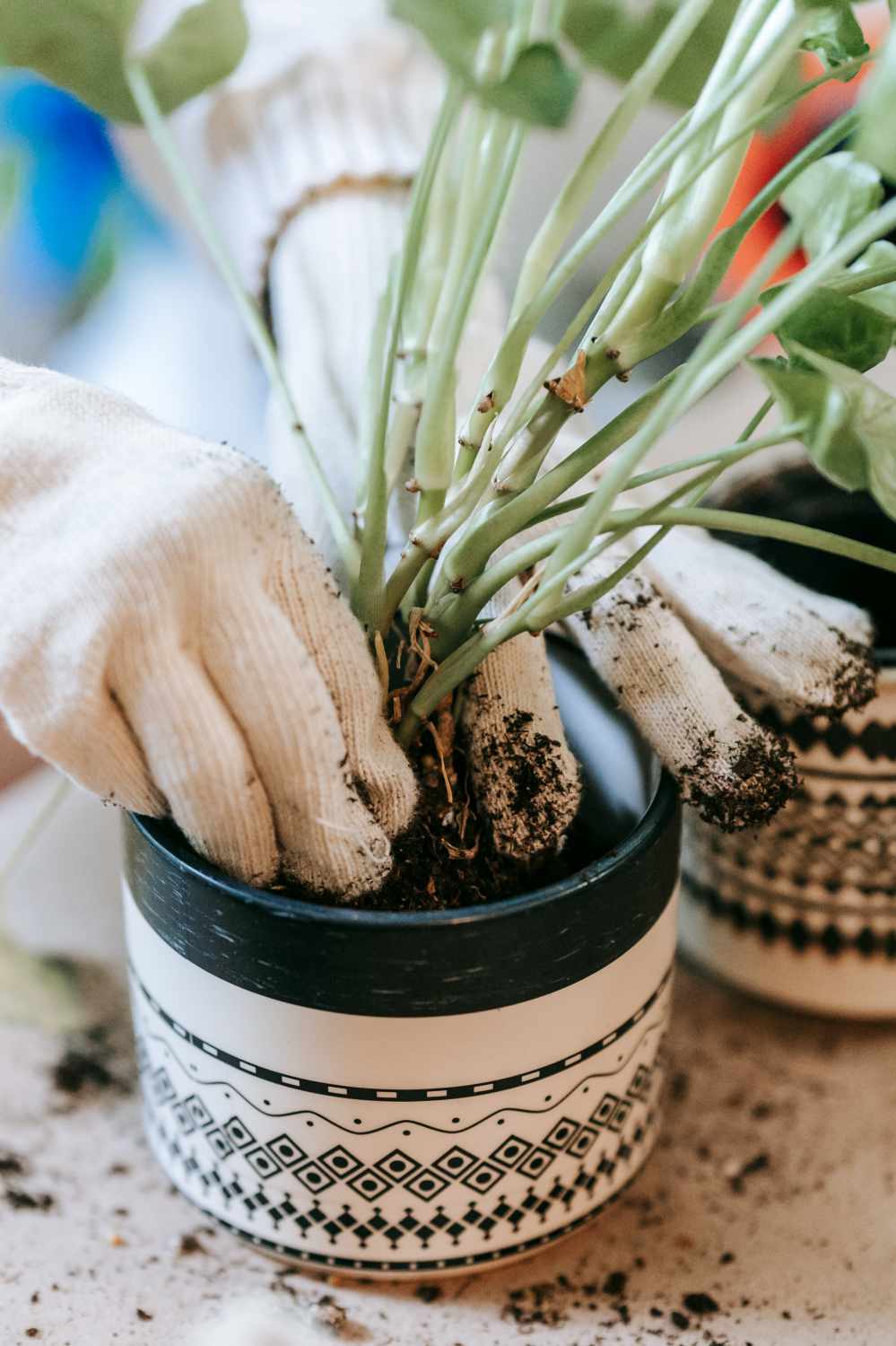
Before you roll up your sleeves and prepare yourself to get down to action, think if your Syngonium would actually benefit from being replanted. This is because every action involving a plant’s root system is stressful. Next on, you should aim to repot your arrowhead plant only during the growing season. Again, due to possible stress.
Psst, if your Syngonium has just been handed to you by the delivery courier, don’t jump on repotting it straight away. Allow the newcomer to rest and recover for about 2 weeks from its journey to you.
How often does an arrowhead plant need to be repotted (replanted)? Usually, Syngonium outgrow their pot in the span of 2 to 3 years. However, if your arrowhead plant is growing crazy fast, then this period can be much shorter. If you are unsure whether your Syngonium is showing signs of being root bound or if the time has come for a bigger size pot, check out our detailed guide on repotting houseplants. But let’s summarize the essentials to repotting your arrowhead the right way below.
How to repot/replant a Syngonium:
- Choose the next pot size (or max 2 sizes bigger) when repotting your arrowhead plant. If you go overboard with the size, your Syngonium might start suffering from rot issues as the potting mix might not have adequate time to dry out.
- Prepare a fresh potting media for your Syngonium. Aroid potting mix would work well here if your plant has been previously grown in soil.
- Gently remove your Syngonium from its current pot. Tap the sides of the root ball to release some of the old growing media. Again, be gentle and try not to disturb or damage the roots.
- Plant your Syngonium in its new pot and water it thoroughly.
- Place your arrowhead in a bright location (no harsh light) and allow it to acclimatize to its new pot.
- Expect that your Syngonium might slow down its growth but once you see that new leaves have started growing, your arrowhead plant is ready to rock n roll once again.
12. Variegated Syngonium Care Tips
Variegated Syngonium are usually as resilient as their green cousins but if your Syngonium is highly variegated, an occasional brown spot here and there might occur. Don’t panic.

Brown parts on the leaves of a highly variegated Syngonium are a common occurrence. And bummer: of course, these brown spots will have to exactly land on the variegated spots too!
This is because variegated plants are a touch more fragile than completely green ones. Why? Because those variegated spots on your Syngonium aren’t able to photosynthesize as efficiently, hence, they are the first ones to “go” whenever your Syngonium is experiencing some stress.
Most often than not, brown spots on a Syngonium Variegata are caused by insufficient lighting. Remember how I said that Syngonium can survive even in a low light location? This is not true when it comes to variegated plants as they require an extra light boost. So if you have a variegated Syngonium, medium to bright light would be best for it.
If the brown spots on your variegated Syngonium look dark, have a soft texture, and appear sort of wet-ish, then they are probably caused by inadequate lighting plus overwatering issues. On the other hand, if the brown spots on your arrowhead look crispy and are appearing more towards the edges of the leaves, then the problem could be underwatering.
Once you figure out what is causing your variegated Syngonium to have brown patches, you can correct the issue and your plant should bounce back without a problem and should keep its variegated leaves just as they were meant to be – colorful and healthy.
If a leaf has brown spots on it, unfortunately, it will not turn back to green. The brown spot itself is rarely affecting negatively your Syngonium but if for aesthetic reasons, you want to remove it, that’s also fine. Ensure to use a cutting tool that has been disinfected prior (eg: with 70% rubbing alcohol) and also leaf a tiny halo, without cutting into the green, healthy tissue of your arrowhead’s leaf.
13. Syngonium Care: Common Plant Issues
Syngonium are fun and nice until something goes wrong with them and they start losing their vigor. Fret not, I got you.
If there is like… just a single leaf suddenly turning yellow on your precious arrowhead plant, chances are: it is normal and not a reason for concern as from time to time plants shed off their older leaves. However, if you notice that your Syngonium doesn’t look like its usual perky self and more and more leaves are turning yellow on your plant, your plant parent alarm should get triggered – something is wrong.
Overwatering is the most common reason why a Syngonium would suddenly start shedding off its leaves. However, although it is the most common one, it isn’t the only one. To help you better diagnose why are the leaves on your Syngonium turning yellow, we have a detailed article for you. Make sure to read our special guide on diagnosing causes of leaves turning yellow on houseplants and how you can help your plant recover.
You should also beware of stem and rot issues with your Syngonium, especially during the winter months when the plant drinks considerably less compared to spring and summer. If you notice that your arrowhead plant is feeling a bit under the weather or if there is a foul smell coming from its pot, always check for rot. Our detailed article on how to recognize and treat rot in plants will help you guide you through it.
Most fungal and bacterial problems are also caused by improper care routines.
Signs that your Syngonium might be facing a fungal problem are: spots on the leaves that might have a rusty, powdery element to them, and they appear to either multiple or grow in size. Fungi thrive in wet conditions with limited airflow. If you suspect that your arrowhead plant is dealing with a fungal issue, isolate it immediately to prevent the problem from spreading to your other plants. Then if only a few leaves are affected and it would not stress your Syngonium too much, remove the affected leaves and dispose of them immediately. Apply an appropriate fungicide afterward and repeat as directed.
Bacterial issues are a world on their own and unfortunately, most of them are not treatable. Bacterial spots on leaves appear as darker, water-soaked spots and there are no visible spores present. Although untreatable, the good news is that bacterial issues in plants are really rare. If you suspect that your plant might be dealing with a bacterial problem, you have to evaluate whether to keep it or dispose of it. In any case: remove it from the rest of your plants asap. Bacteria, like fungi, thrive in conditions that are moist, warm, and without sufficient airflow.
To prevent fungal or bacterial problems on your Syngonium, ensure that there is always a good airflow around the plant. A small, mobile fan might come in handy here. Avoid getting the leaves of your Syngonium wet (a reason why we are against misting houseplants in general) to limit the spread of potential fungal spores and to avoid creating a favorable environment for fungi to thrive on.
Once again, most causes of a Syngonium experiencing distress are based on environmental factors that can be corrected. Fungal and bacterial diseases on houseplants are fortunately not as common as most think.
14. Can You Grow Syngonium in a Terrarium?
Some Syngonium grow quite compact and remain rather small so yes, they can be grown in a terrarium. However, if you want to grow your arrowhead plant in a terrarium there are a couple of things to keep in mind.
The size of your terrarium matters. Choose a rather large container for your Syngonium as these tropical plants grow quite fast. Opt for younger plants and for varieties that would grow more bushy than stretchy.
We have a DIY Terrarium Set in our shop just for the occasion! Make sure to check it out as it contains the substrates that you would need to build your Syngonium terrarium in no time.
Alternatively, Succulents & Cacti are even more suitable to be grown in a terrarium and they make the whole terrarium-building experience beginner-friendly.
15. Are Syngonium Toxic?
Unfortunately, yes. Your arrowhead plant is toxic to animals and humans. Syngonium are mildly toxic due to calcium oxalates that is produced as a natural feed-defense. Bear in mind, that you need to ingest the plant for it to be toxic.
Some symptoms after ingestion include (but aren’t limited to): mouth, throat, and GI irritations and feelings of burning.
Thus, keep your Syngonium away from fluffy cats, dogs, and curious little hands.
Syngonium Care: Final Thoughts
In this Syngonium care guide, different plant preferences and care needs were discussed. Syngonium are absolutely beginner-friendly plants that can tolerate even a low light location, grow fast, and aren’t too fussy about their care routine usually.
The secrets to having a happy Syngonium at home are simple: provide the plant with bright light, water it regularly, and feed it nutritiously. In no time, your arrowhead plant will start growing like crazy. And since Syngonium are just so awesome, once they outgrow their spot, you can simply cut them down and propagate them with ease.
Hopefully, this detailed Syngonium care guide answered many questions that you might have related to the care requirements of the arrowhead plant. And if you are just beginning your gardening journey, hopefully, your worries were put at ease and you can enjoy the stunning colors of your Syngonium (whichever variety your plant is!).


